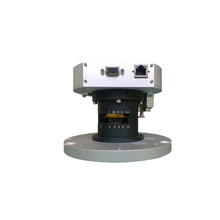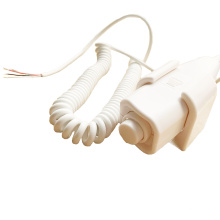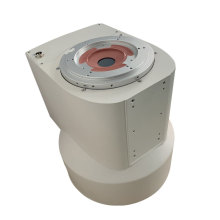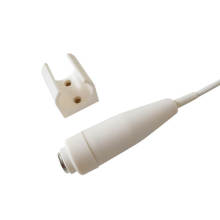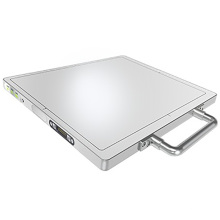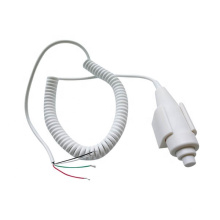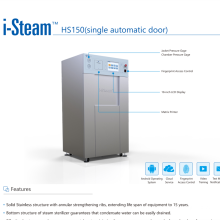Talking about Screen Printing of Glass
2021-04-25
Glass as a building decoration material has a flat and transparent, can block wind and rain, easy to scrub and other advantages. After the screen printing, the glass is used for indoor and outdoor decoration more popular, and it greatly meets people's life and aesthetic needs. A variety of beautiful patterns are contending for creativity and exquisite work. Glass containers have begun to develop into medical supplies and industrial products. The high quality of glass products decorated with screen printing technology will become a new growth point for glass printing.
First, the glass screen printing process According to the principle of screen printing, the ink is printed on the surface of the glass, and then the ink curing measures, the printed pattern is strong and durable. The process flow is as follows: Stretching → Sizing → Drying → Printing → Developing → Drying 平板 Flat glass → Cutting → Edging → Cleaning and drying → Printing ↓ Sintering 1. Glass for printing Cut glass according to user requirements, which can be the rule The shape can also be an irregular shape, and then the edge grinding process, then cleaned, dried and used. Here special attention should be paid to the surface of the glass. 2. Selection of screens Screen printing plates used for glass printing are the same as screen printing plates in general. Synthetic fiber screens, stainless steel screens, and natural fiber screens are used for glass screen printing plates. When the general color material is printed, the above screens can be used. In general, inexpensive synthetic fiber screens are selected; when used as gold and silver decorations, stainless steel screens cannot be selected. The specifications of the screen generally use 270-300 mesh. 3. The choice of the network frame At present, the more formal, less deformable frame is aluminum alloy frame, the size should be larger than the pattern, the specific size should be the pattern of the outer edge of the frame should be between 70 ~ 100mm. In addition to the selection of the frame, its strength is very important, the key is that the rigidity in the horizontal direction is sufficient. 4. Stretch net Choose mesh and net frame, combine the two, this is stretch net. There are many ways to stretch the net, and manual, mobile, and pneumatic methods can be used. At present, advanced pneumatic screens that can stretch high-quality screens are pneumatic stretching machines. The requirement of the stretch net is that the tension is uniform, the net latitude and longitude are kept vertical, and the adhesive net is firm and cannot be relaxed.
5. Selecting Photosensitive Adhesive Currently available on the market are dichromate, diazonium, and iron salts. The requirements for photo-sensitive adhesives in silk screen printing are: good plate-making performance and ease of coating. Photographic range of 340 ~ 440nm, good performance, high resolution, good stability, easy storage, and economic health, non-toxic and pollution-free. The requirements for printing on photosensitive materials are: the film formed by the photosensitive material is adapted to the performance requirements of different types of ink, has a considerable resistance to printing, can withstand the scraping pressure of the squeegee a considerable number of times; the binding force with the screen is good, when printing Does not produce film failure; easy to peel, conducive to the use of screen plate material recycling. 6. Shaiban After selecting the above materials, apply the sensitized adhesive in the darkroom; require uniform, then dry, generally require coating twice. Shaiban requires exposure on a cold light source plate, and the exposure time is determined according to the pattern, generally between 12 and 30 minutes. After the exposure and development, a screen printing screen was prepared. 7. Printing Flatbed glass presses are available in manual, semi-automatic, fully automatic types. Manual presses are suitable for small-batch, small-format flat glass. Semi-automatic, full-automatic printers are suitable for printing large quantities of large-format, multi-color printing with the advantages of accuracy and speed. The largest semi-automatic printer can print 2000 x 1500mm size glass. Fully automatic printers are generally used for the printing of windshields in automobiles. Several companies abroad can provide such devices. 8. Ink Inorganic glass screen printing with two kinds of ink, one kind is the inorganic pigment after grinding, to reach a certain degree of fineness. Plus acrylic resin, screen printing on the glass surface, the need for high temperature (600 °C above) roast 1 ~ 2min, the ink layer and the glass surface layer melt together, excellent fastness. The heat-resistant temperature of this ink is above 600°C. However, because this screen printing process is costly and the process is more complicated, it is rarely used in the screen printing industry. The other type is inorganic glass ink with polymer compound as binder. Both amino type and epoxy type are required to be baked, which is widely used in the domestic market. The application of ink is screen printing after baking at l300 ~ l 400 °C 30min, the heat-resistant temperature of this ink is relatively low. However, the baking time is longer, the ink has good fastness and hardness, and the brightness is also very good, and it can resist low concentrations of electrolytes and solvents such as ethanol, acetone, benzenes, and cyclohexanone. 9. Sintering Glass is an amorphous inorganic material that softens as the temperature increases, and the glass deforms when heated to the softening temperature of the glass.
The glass glaze is decorated on the surface of the glass by screen printing, and it needs to be sintered on the glass surface by high temperature sintering. However, the sintering temperature must be lower than the softening temperature of the glass being decorated to ensure that the decorative glass is not deformed. The sintering temperature of general glass glazes is not higher than 520°C and is usually controlled at 480-520°C. Low-temperature glass glazes are produced by several domestic manufacturers and are relatively inexpensive. There are several companies in foreign countries that can provide similar products, but the price is a difference of one to twenty times that of domestic products. Domestic consumption levels have not yet reached the level of using such glazes, but glazes provided by foreign countries are indeed much better than domestic colors and levels. To improve the quality of decorative glass, it is inevitable to improve the grade of glaze. The sintering equipment includes a flame furnace and a resistance furnace. The resistance furnace is divided into a vertical suspension type and a horizontal roller type according to the hanging manner of the glass. The vertical hanging sintering furnace has the advantages of small sintering distortion and a yield of 95% or more, but the equipment is complicated. Horizontal roller type adjustment is not easy to appear large deformation, low yield. In addition, the use of horizontal tempering furnaces for the production of decorative glass is also feasible. The grade of the product is improved and the safety is also guaranteed. It is an ideal sintering method.
Second, the glass screen printing process prone to failure Screen printing failure, some of the reasons are single, but more is the result of cross-effects of various reasons. This is the operator in the judgment of the reasons for the failure of glass screen printing, to take appropriate countermeasures should pay special attention: 1. Paste paste version is also known as blocking version, refers to the screen printing plate through holes in the printing part of the ink can not be printed Transfer to the substrate. The appearance of this phenomenon will affect the printing quality, even if it is severe, it will not be able to print normally. The cause of the stencil phenomenon in the screen printing process is intricate. The reasons for squashing can be analyzed from the following aspects: 1 Glass causes: The glass surface is not treated cleanly, and there are watermarks, paper prints, mimeographs, fingerprints, dust particles, and other contaminants. Thus resulting in paste version; 2 workshop temperature, humidity and ink properties. Screen printing workshops are required to maintain a certain temperature of about 20°C and a relative humidity of about 50%. If the temperature is high and the relative humidity is low, the volatile solvents in the ink will evaporate quickly, and the viscosity of the ink on the screen will become high, thereby blocking the Live network. Another point that should be noted is that if the downtime is too long, it will produce a paste version phenomenon, the longer the paste version becomes more serious. Second, if the ambient temperature is low, poor ink flowability is also easy to produce paste version; 3 screen printing plate reasons. The prepared screen plate can be used after being rinsed with water and dried before use. If you make a good version, do not print it too late. In the process of preservation, dust adheres more or less, and if it is not cleaned during printing, it will cause a paste. 4 reasons for printing pressure. Excessive embossing force during the printing process will cause the blade to bend. The blade is not in line contact with the screen plate and glass, but is in surface contact, so that each scratch can clean the ink and leave residual ink. After a certain period of time, the conjunctiva will cause a paste. 5 Reasons for improper clearance between screen plate and glass. The gap between the screen printing plate and the glass should not be too small. When the gap is too small, the screen plate cannot be detached from the glass in time after the squeegee is printed. When the screen plate is lifted, a certain ink is stuck on the bottom of the printing plate, which is easy to cause paste. board. 6 The reason for the ink is that when the pigment and other solid particles in the screen printing ink are large, the phenomenon of blocking the mesh hole is likely to occur. In addition, the mesh size and through-hole area of the selected mesh are smaller than those of the ink, so that it is one of the reasons why the coarse-grained ink does not easily pass through the mesh. For stencils caused by large particles of ink, it is possible to solve the problems when manufacturing the ink. The main method is to strictly control the fineness of the ink.
In the printing process, the increase in ink viscosity caused by paste version, the main reason is that the screen printing ink solvent evaporation, resulting in increased ink viscosity, and closure of the network phenomenon. If the area for printing graphics is large, the ink on the screen printing plate will consume more, and the stencil printing will be less. If the picture area is small, the ink consumption on the screen printing plate is small, it is easy to cause paste printing. The countermeasure is to use a small amount of ink refilling principle. Poor flow of ink will cause the ink to produce a paste when not passed through the screen. This can be solved by lowering the viscosity of the ink and improving the fluidity of the ink without affecting the print quality. After a paste failure occurs, an appropriate solvent scrub can be used depending on the nature of the ink on the plate. The method of scrubbing starts from the printing surface and gently wipes from the center to the periphery. Check the plate after wiping, if any defects should be promptly repaired, and re-start printing after repair. It should be noted that the plate is thinned each time it is scrubbed, and if it is wiped out, it causes a major defect in the plate. 2. Insufficient fixation of ink on glass When printing on glass, it is very important that the glass is subjected to strict degreasing and pre-treatment inspection before printing. When the surface of the glass adheres to substances such as greases, binders, and dust, poor adhesion between the ink and the glass can result. 2 Insufficient adhesion of the ink itself causes the ink film to be stuck firmly. It is better to replace other inks for printing. Improper use of dilute solvent can also cause the phenomenon of ink film not adhered firmly. When selecting the dilution solvent, the nature of the ink should be taken into account to avoid the occurrence of the phenomenon that the ink and the substrate are not firmly bonded. 3. Improper ink film thickness unevenness, due to a variety of reasons, in terms of ink is poor ink deployment, or the normal deployment of ink mixed with ink, when printing, due to the role of solvent expansion, softening, The mesh that should be penetrated by ink was blocked and acted as a plate to prevent the ink from passing through. In order to prevent such failures, the formulated ink (especially the old ink) should be screen-filtered before use. When you reuse a used plate, you must completely remove the old ink that has adhered to the plate. When the plates are stored after printing, they must be fully washed (including scrapers). If the tip of the ink return plate is damaged, a trace will appear along the direction of movement of the squeegee. When printing glass, there will be obvious ink inconsistencies. Therefore, it is necessary to protect the front end of the squeegee so as not to cause damage. If it is damaged, it must be grinded with a grinder. In addition, the unevenness of the printing table also affects the uniform ink. The convex ink layer is thin, and the recessed ink layer is thick. This phenomenon is also called ink inhomogeneity. In addition, if the back surface of the substrate or the printing table adheres with dust, the above failure may occur.
4. Pinholes Pinholes are the biggest headache for workers working on glass screen printing. The reasons for the occurrence of pinholes are also varied, many of which are currently unexplained, and some are still problems of quality management. Pinholes are one of the most important inspection items in the inspection of printed products. 1 Dust and foreign objects attached to the plate. At the time of plate making, there are some sols mixed into the water wash image. In addition, when the emulsion is applied, dust may be mixed in, and pinholes may be formed on the screen. These tests can be found and repaired promptly if they are checked. If dust and foreign matter adhere to the screen, blocking the screen openings can also cause pinholes. Before the formal printing, carefully check the screen plate to eliminate the dirt on the plate; 2 The cleaning of the glass surface. Before printing, the glass plate should be pre-treated to make its surface clean and printed immediately. If the glass is processed, it will not be printed immediately and it will be recontaminated. After pre-treatment, dirt such as grease can be removed, and dust attached to the surface can also be removed. Pay special attention to the fact that the fingerprints of the hand will also adhere to the printed surface when the glass is moved by hand, forming pinholes during printing.
5. Bubbles Bubbles appear on the ink after printing on the glass. The main reasons for the bubbles are as follows: 1 The substrate is poorly processed before printing. Substrate surface attached to dust and oil traces and other substances; 2 ink bubbles. In order to adjust the ink, adding solvents and additives to stir, the ink will be mixed with some bubbles, if placed regardless of the low viscosity of the ink will naturally deaeration, high viscosity inks and some can not be natural deaeration. Some of these bubbles are naturally eliminated in the printing process due to the transfer of ink, while others become larger and larger. In order to remove these bubbles, defoamers should be used. The amount of defoamer added in the ink is generally about 0.1 to 1%. If the amount exceeds the prescribed amount, it will have a foaming effect. After the ink is transferred, even if it is foamed, as long as the wettability of the substrate and the ink flowability are good, the bubbles on the surface of the printing ink film will be gradually eliminated, and the ink forms a flat printing ink film. If ink bubbles are not eliminated, the ink film will form a ring-shaped uneven film surface. Bubbles in general inks can also be degassed due to the action of the screen when they pass through the screen. 3 Bubbles can also occur if the printing speed is too fast or the printing speed is uneven. The printing speed should be properly reduced to maintain the uniformity of the printing speed. 6. Electrostatic Discharge The electrostatic current is usually very small, but the potential difference is very large, and there may be phenomena such as attraction, repulsion, conduction, and discharge. 1 adverse effects on screen printing. In the screen during printing, the rubber portion and the screen are charged by the pressure scraping of the blade rubber. The screen itself is charged, it will affect the normal ink, resulting in blockage failure; it will be absorbed by the screen at the moment of the output of the substrate; 2 methods to prevent static electricity. The methods for preventing static electricity generation include: adjusting the ambient temperature and increasing the air humidity; the appropriate temperature is generally about 20° C. and the relative humidity is about 60%; static electricity can be transferred in the wet air; the net pitch is reduced, and the printing speed is reduced.
7. Expanded ink film size After screen printing, the print size sometimes increases. The main reason for the increase in printing size is the relatively low viscosity of the ink and excessive fluidity; the size of the screen printing plate is also the cause of the increase in the printing size. In order to avoid the ink flowability caused by the overflow of the ink after printing, causing the print size becomes larger, consider increasing the viscosity of the ink to reduce the ink's fluidity. When making screen printing plates, we must strictly guarantee the quality of screen printing plates and ensure the screen plate tension. 8. Part of the ink leaked from the printing plate of the printing plate is called ink leakage fault. The reason is: some of the scraper is injured; the pressure of the scraping ink is large; the gap between the plate and the glass is too large; the plate frame is deformed greatly. , Local printing pressure is not enough: ink is not uniform; the screen is too thin; printing speed is too fast. If dust is mixed on the glass and in the ink and printing is performed without processing, the plate will be damaged due to the pressure of the squeegee; when the plate is under-exposed, pinholes, etc., will cause ink leakage in the plate. At this time, adhesive tapes, etc. can be used for emergency handling from the back of the plate. If this operation is not very fast, the ink on the layout will be dried, and the whole of the plate will have to be wiped with solvent. Wipe plates are also the cause of delamination of the plate, so it is best avoided. The ink leakage of the printing plate often occurs in the ink staying part, so it is better to strengthen this part in the plate making.
9. Moisture Ink refers to the blotting of graphic and textual parts of the glass surface. This phenomenon damages the printing effect. Glass screen printing is easy and this phenomenon occurs. The reasons are as follows: printing speed and ink drying are too slow; ink layer is too thin; ink thixotropic; electrostatic effects; Dot blots. The improved methods are: improving the fluidity of the ink; using a quick-drying flux; printing with a high-viscosity ink as much as possible: increasing the wet film thickness of the ink, using an ink made of a pigment with a small oil absorption amount as much as possible: minimizing the influence of static electricity . 10. Image Deformation The printing pressure applied by the squeegee to the printing plate during printing can make the line contact between the printing plate and the printing object, and it should not exceed. If the printing pressure is too high, the printing plate contacts with the printing material and the screen may expand and contract, causing the printing image to be deformed. Screen printing is the smallest type of printing in various printing methods. If we forget this, we cannot print good prints. If the pressure cannot be printed without increasing the pressure, the gap between the plate surface and the glass surface should be reduced, so that the pressure of the blade can be reduced.
Third, the application of screen printing plate glass and its market prospects Screen printing plate glass is widely used in all corners of people's lives: You can easily display windows, architectural space division, building beautification, car windshield and mosaic glass and other places easily Find their presence. Simultaneously. They are also widely used in furniture decoration and game tools, as well as countless decorations and artistic creations. Screen printing has also become part of the creative design work for glass manufacturing. One can print color images directly to the glass surface by screen printing. In addition, it can also be used to temporarily cover the untouched part of the glass surface, or to print preservatives and other additives on a part of the surface of the glass, so that it is not affected by the etching or sanding process. In contrast, special inks can also be screen printed directly to create etched or matte finishes. sometimes. People can also use the strong hiding power of screen printing, such as printing a thin layer of conductive material on glass, to make anti-ice (frost) devices for windows.
Screen printing continues to expand in the field of flat glass decoration. In addition to its application to a variety of materials, printing materials, another important factor is that it can meet a wide range of different sizes, different weights of flat glass substrates. Moreover, due to the absolute superiority of screen printing in super-large-format image printing, it has further strengthened its leading position in the development of the entire flat glass printing industry. Especially in recent years, the demand for large-format flat glass printing has risen sharply. In fact, due to the rapid development of screen printing in the field of large-format flat glass decoration, printing equipment manufacturers are also constantly improving to meet more demanding printing requirements, especially in areas such as flat glass, resulting in many of the world's most flexible Equipment is widely used in the printing of building boards. The application of screen printing in flat glass decoration will continue to develop and it will continue to expand its applications in glass decoration. Screen printer has faster printing material transfer system, and more advanced power supply system, combined with powerful PLC (Logical controllable device)
With China HAE Wall printer you can color and animate your home environments. You can print on wall, reproduce directly onto walls any colors images favorite, changing and
render unique your intimate spaces. As a digital fresco, but you can choose the photos. Any digital file you want, any size you prefer and any surface you have, Then Mural Printer and canvas printing machine can print it out in high quality colors durable, Direct to wall inkjet printer can be used in homes, offices, hospitals, schools, restaurants and cafes, Gyms, shipping centers , Childcare centers etc.
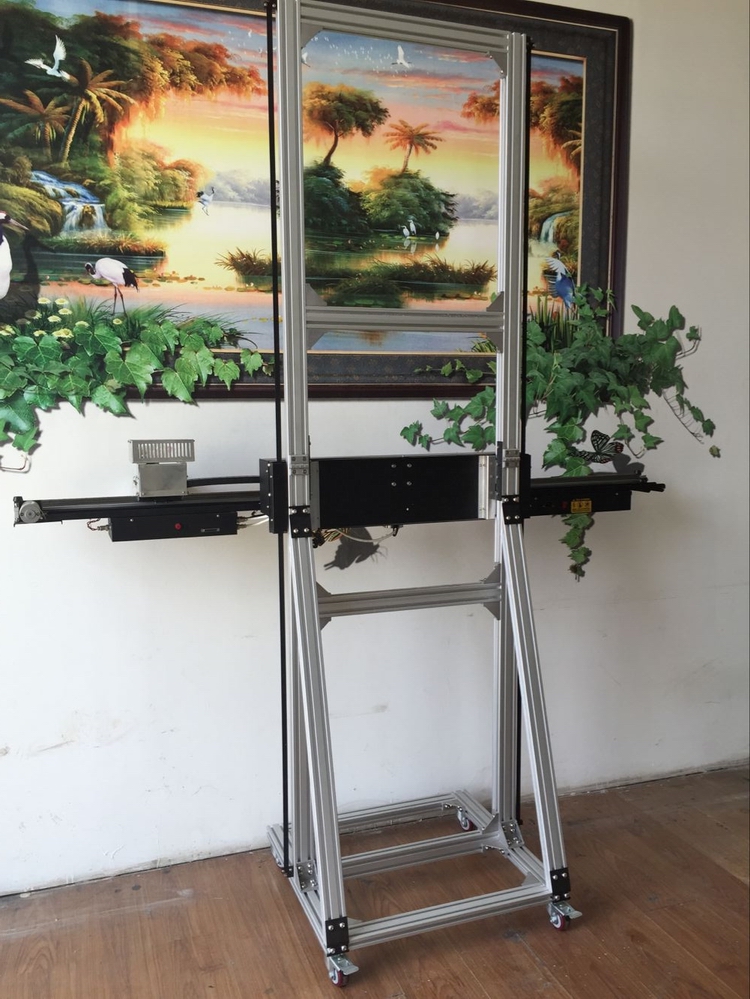
Horizontal Wall Printer, 3D Horizontal Wall Decor Printer, Horizontal Water Based Ink Wall Printer, High Resolution Horizontal Wall Printer
Medical Diagnosis Equipment Co., Ltd. http://www.lnsuccess.com
